Buffalo Stories on La Rivierre Grande
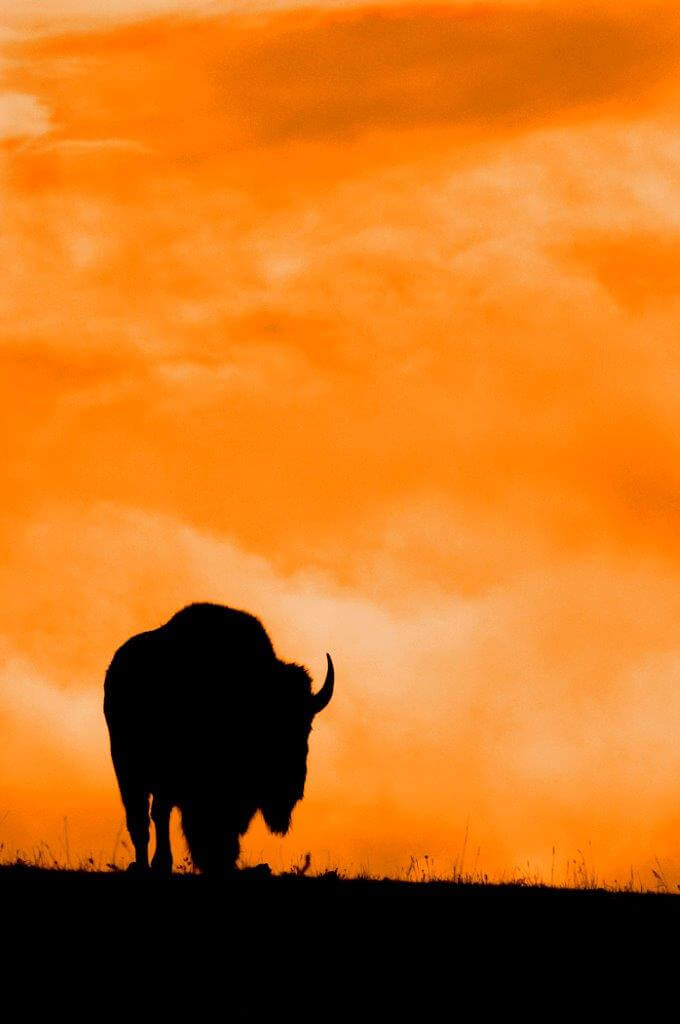
What is the future for our beloved Buffalo?
Recently we gathered a small group around my kitchen table—a few people interested in what we can do with all our buffalo information. Informally we call ourselves Brainstormers.
We had just finished a successful tour of our historic buffalo sites here at home that we had arranged with the BSC Bison Symposium.
When Bismarck State College decided to put on a Bison Symposium led by their retiring director Dr. Larry Skogen, we got involved. In fact we may have helped inspire the whole thing.
After all, Larry grew up in Hettinger, where his parents ran a hardware store. He knew something of our buffalo history.
By this time we had uncovered several even more interesting facts about buffalo living on these lands. It wasn’t just the 3 last great buffalo hunts that happened here. There were more stories. One by one, they began revealing themselves.
Marvelous stories. Word of mouth heroics, problems and successes. Survival stories.
It was like peeling an onion, one more layer beneath another as layers unfolded, one by one.
Shadehill Buffalo Jump
For instance: The excavation of our buffalo jump at Shadehill revealed how primitive hunters likely used it as long as 7,000 years ago. Wow!
Dakota people don’t boast and brag much. So we dared not claim Shadehill had been a buffalo Jump. Even though we believed that’s what the layers of buffalo bones on the face of the cliff meant.
One layer stretched 12 feet thick all the way across the 100-foot cliff up and down the river! And below that was another 4-foot layer.

Shadehill Buffalo Jump is now mostly under the Lake waters. The bones are long gone.
Then all of a sudden we noticed that South Dakota Game, Fish and Parks, which manages recreation at Shadehill Lake had put up a new sign—of buffalo jumping off the cliff.
And we discovered 3 teams of archaeologists had reported their findings here—one each from the University of ND, SD Game, Fish and Parks and the US Forest Service.
UND even published a book of their findings. Local County Agent Vince Gunn—who has lived his entire life across Shadehill Lake from the jump—lent us his copy.
Our jump was real. There was an archaeology book and official sign verifying it.
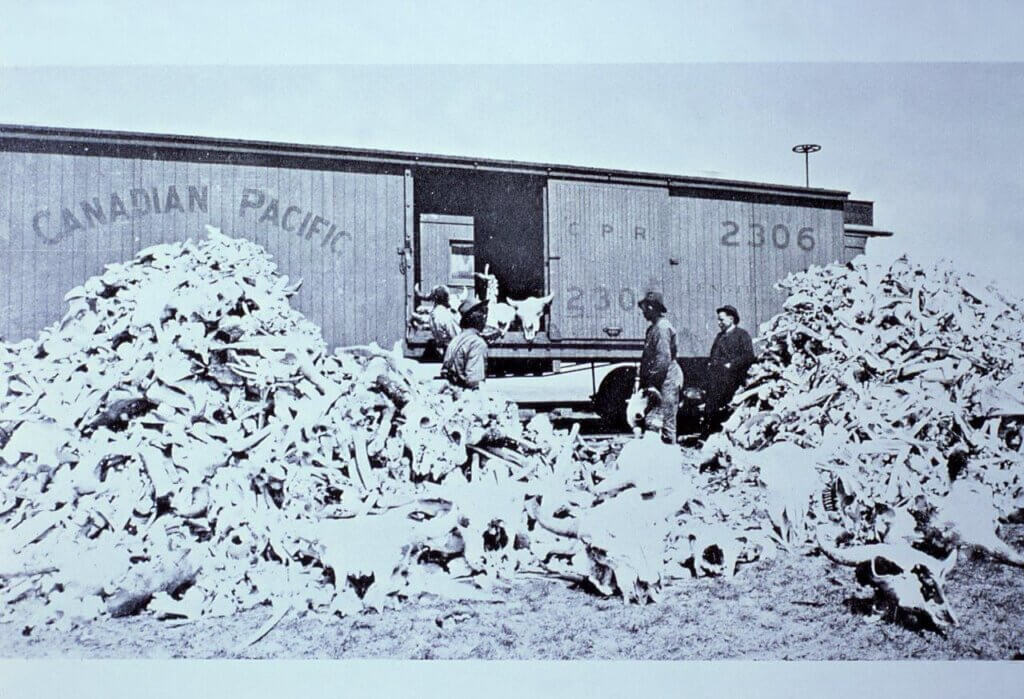
The bones from Shadehill—and other Buffalo Jumps—were bulldozed out and shipped to the west coast munitions plants to be used for explosives in wartime. Photo courtesy NPS.
Unfortunately, the buffalo bones that once showed in two deep layers on the face of the cliff were gone. The last bones were bulldozed out and hauled west by train to manufacture explosives during World War II—as happened to many other buffalo jumps across the US and Canada.
But our jump was real.
Duprees Rescued Young Buffalo Calves
But wait! There’s still more.
Not just the last great hunts and near extermination. Our tragic buffalo story did not end there.
Most marvelous of all—was the miracle of how the buffalo evaded extinction.
Fortunately, William Hornaday was wrong—he didn’t write the last chapter on buffalo after all in 1889! LA Huffman didn’t shoot photos of the last buffalo lying dead across the Plains in 1880!
Instead, a few people from across the United States and Canada rescued some young buffalo calves and nourished them into viable herds.
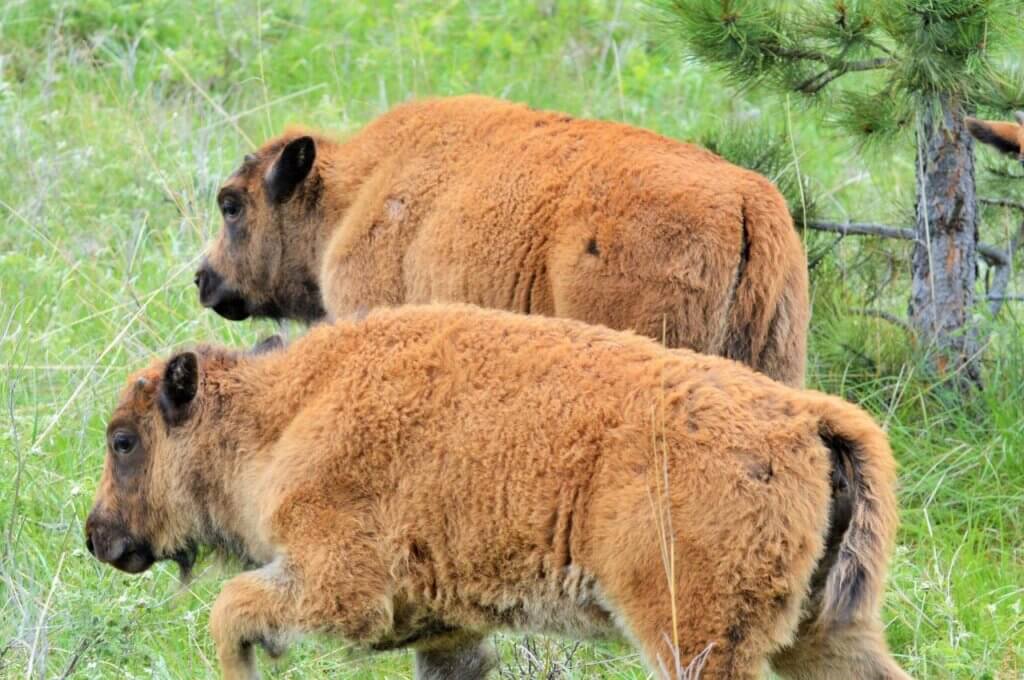
The Duprees rescued 5 calves and perhaps added others brought into their herd by friends. Photo SD GFP, Chris Hull.
We were happy to discover one of the 5 rescuing families turned out to be a local Native family. In fact 3 of the 5 rescuing families had Native American roots. They knew how much the buffalo meant to their culture.
All 5 family groups were western ranchers and had hunted buffalo.
Just before the end, the Duprees rescued a few newborn calves on the South Grand River. The Dupree brothers and maybe their sisters too—theirs was a large family—had traveled some 50 or 60 miles from their fur-trading homes at the mouth of Cherry Creek on the Cheyenne River—a two-day trip in the spring to the Slim Buttes with team and wagon.
At home they found cows to mother the young calves. Pete Dupree must have done things right to avoid the typically high death loss of orphan buffalo calves.
For many other would-be rescuers, the small calves died of starvation before they received the nourishment they needed. Captured buffalo cows and older calves simply stiffened out and died instead of giving in to “being saved.”
Near the jump I even discovered a possible Box Canyon that a small group of ancient hunters might have used successfully to trap a few buffalo before horses arrived on the Grande.
We had the right pieces for another book.
A Book to Celebrate Buffalo Saga
My next book would tell the entire story. And it all happened right here in our own community—the Hettinger ND and Lemmon-Bison SD area.
It would celebrate the buffalo and honor the Native Americans who integrated them into their own culture. The thousands of years when Native people of the Plains hunted on foot and hauled all their possessions with them in dog travois.
The exciting arrival of the horse culture that meant Native people could travel faster and hunt more efficiently. How the buffalo were almost exterminated. And how they thrive today.
Pete Dupree’s herd kept growing in the same area they were rescued—on the South Grand.
By the time he died in 1898 his buffalo herd had increased to 83. They were sold to Scotty Philip who also ran livestock on reservation land.
Gradually they were replaced by Native American tribal herds and the private herds we see in this same area today.
Noted leaders including President Theodore Roosevelt developed sanctuaries for Bison to live and passed laws to protect them—and Roosevelt the conservationist earned his place on Mount Rushmore in the Black Hills.
Yet Roosevelt and other easterners could never have done what they did to help buffalo survive without the efforts of calf rescuers in the west.
Let us never forget who saved the buffalo on the ground.
Ordinary, local people. If not for them, we’d have no live buffalo to celebrate today.
I didn’t want people to forget our Buffalo History.
Pioneer knowledge can be forgot so easily. For example, the disappearance of buffalo bones from our Buffalo Jump at Shadehill. Where did they go?
The archeologists who came from the university apparently didn’t extend their research to the know-how of local people who live here. The new SD sign read briefly, “Sadly, the site slid into the reservoir.”
However, an early settler Don Merriman who lived there, now long-gone, told me what really happened to the bones. During the early 1940s and the beginning of World War II, he was there when his neighbor who owned that land, bulldozed the bones out of the cliff and hauled wagon loads to the train station.
From there they were shipped to factories on the West Coast, the phosphorus extracted for the manufacture of explosives.
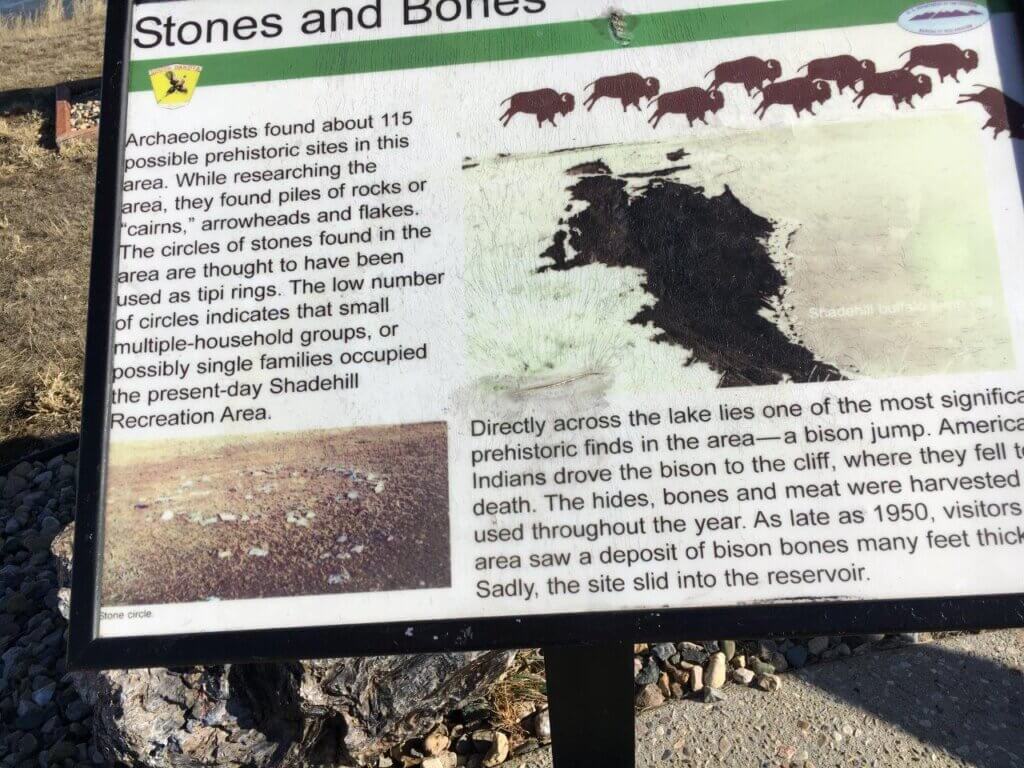
The last line on the sign for the Shadehill Buffalo Jump read, “Sadly, the site slid into the reservoir.” Photo FMB.
La Rivierre Grande
Between the North and South forks of the Grand River, a big chunk of North and South Dakota gets watered.
In researching the river’s history, John, one of our Brainstormers, found early French fur traders spelled it with a final “e.” In fact in their journals he says they put the river first: “La rivierre Grande.”
This may have been even before our lands were owned by the United States—with the Louisiana Purchase from the French in 1803.
The name Grande intrigued our Brainstormers. As we talked about what we have, we discovered the magic of our history, especially on the Grand River, or La rivierre Grande as we started calling it.
We realized this river has always been a place where live Buffalo graze along its banks.

Buffalo have always grazed the meandering banks of the North and South Grande since time immemorial—and probably always will. Photo FMB.
In fact, there’s never been a time when buffalo did not thrive in La rivierre Grande area.
It is one of the few places in North America—maybe the only place—where someone saved calves on their homeland and kept them there. Most others caught their calves while hunting elsewhere.

The Dupree buffalo always grazed the banks of La rivierre Grande and with the cultural importance of today’s Native American tribal herds, probably always will. Photo NPS.
A Book to Celebrate Buffalo Saga
My next book would tell the entire story. And it all happened right here in our own community—the Hettinger ND and Lemmon-Bison SD area
It would celebrate the buffalo and honor the Native Americans who integrated them into their own culture. The thousands of years when Native people of the Plains hunted on foot and hauled all their possessions with them in dog travois.
The exciting arrival of the horse culture that meant Native people could travel faster and hunt more efficiently. How the buffalo were almost exterminated. And how they thrive today.
But one day my former editor and co-worker Kendra Rosencrans, home from Seattle on vacation, looked at the contents of my planned book and burst my bubble.
“People don’t read books anymore!” she said.
Ouch! Can that be true?
Well, I took her advice and finished the Self-Guided Tour first, “Buffalo Trails in the Dakota Buttes.” An action book with 8 historic sites in our area and 2 more sites to visit— tribal herds and the Buffalo Museum in Jamestown, ND. The full buffalo story!
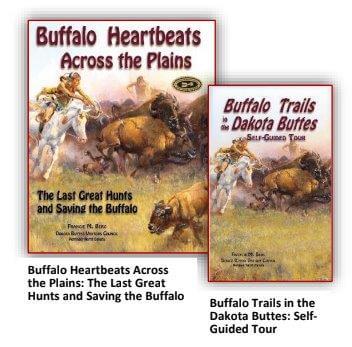
First the Self-Guided Tour—Buffalo Trails in the Dakota Buttes; then Buffalo Heartbeats Across the Plains—the rest of the story.
The next year we published “Buffalo Heartbeats Across the Plains.” More stories. It won three National Awards, including a Spur Award.
BSC Bison Symposium
Bismarck State College took on the June Bison Symposium with enthusiasm. What other University institution has dared to put on a 3-day event that includes all we put into this one?
Academic research. Native American voices telling how their culture is intimately bound up with the buffalo. History tours of where it all happened. A close encounter with live buffalo on the move. And a lot of great bison food for everyone, including a final Bison Stroganoff dinner.
The second day the symposium visitors came on our tour to the Hettinger-Lemmon area. About 80 people rode the 2 travel buses that day to our special Historic Buffalo sites.
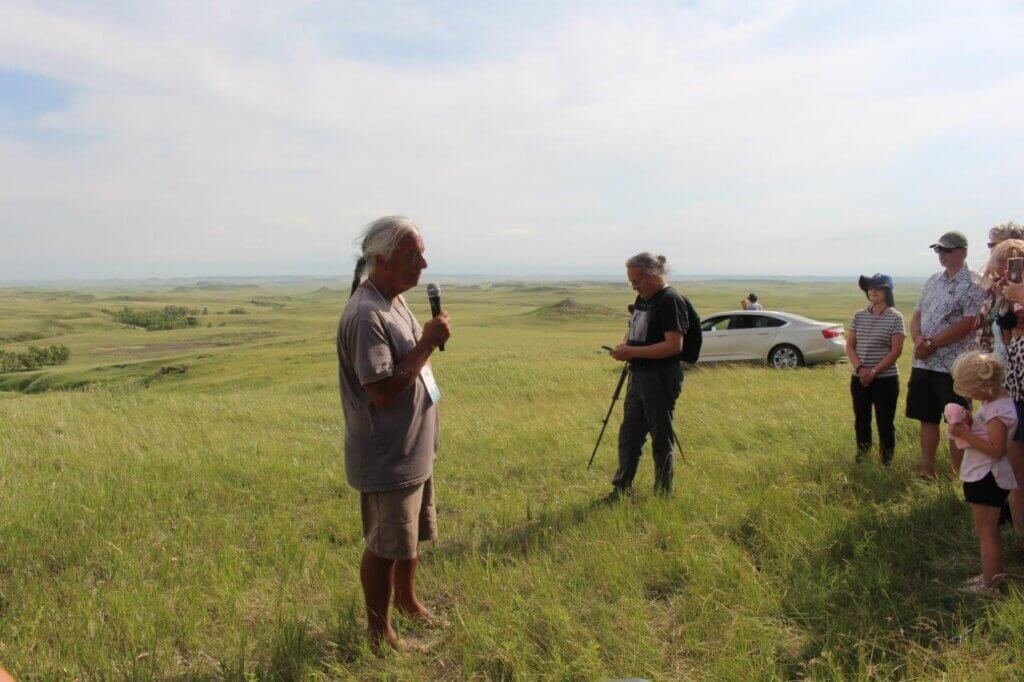
At the Sitting Bull Last Stand hunt site Kevin Locke and Dakota Goodhouse, Lakota storytellers, told about features and plants on these lands—once part of the Great Sioux Reservation—that had special meaning for their culture. Photo Jim Kambeitz.
Riding along on the buses from Bismarck were Lakota storytellers Kevin Locke and Dakota Goodhouse. Our Native American friends know every prominent butte for miles around. This is Lakota country and it seems they can tell a story about each butte and landmark we see. We loved hearing those stories in their own voices.
People on the tour said they enjoyed everything—the stories, and driving among 400 live buffalo while the manager, Jim Strand circled his herd with the feed wagon.
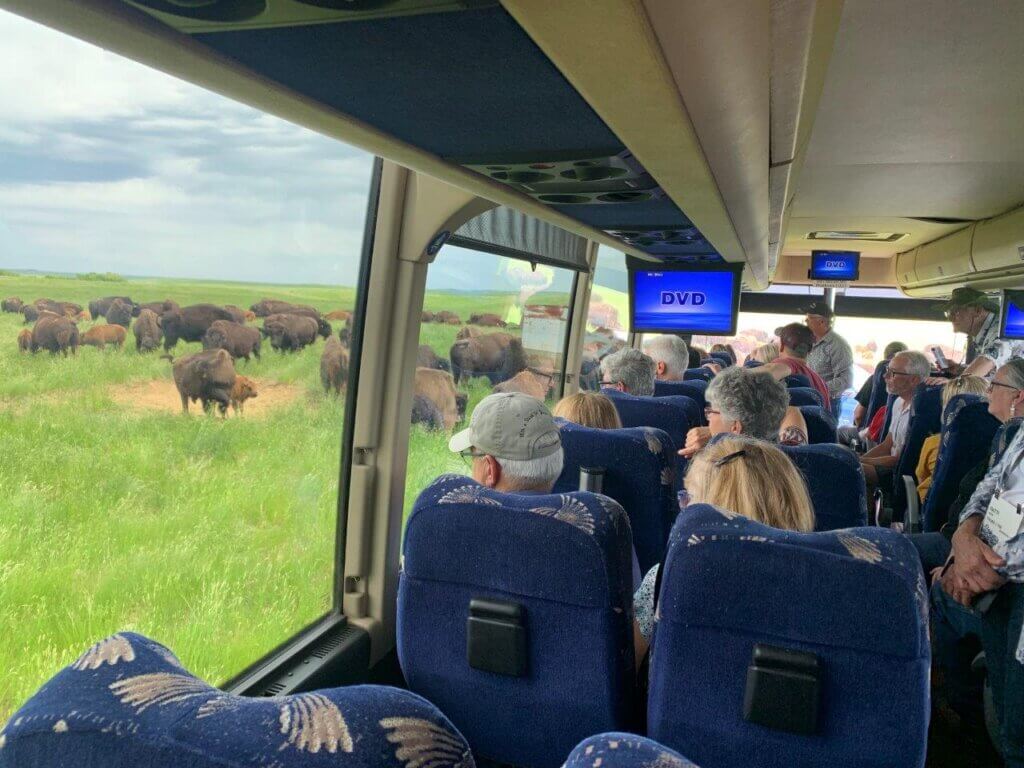
Herd manager Jim Strand came on the bus to explain how he cares for the big Johnson herd of 400. The yellow circle in the foreground marks a buffalo wallow used by the bulls to get rid of their winter hair and parasites, as well as to mark their territory in rut. Photo by JK.
The buffalo came running, grunting and snorting and surrounded us—safe inside the buses.
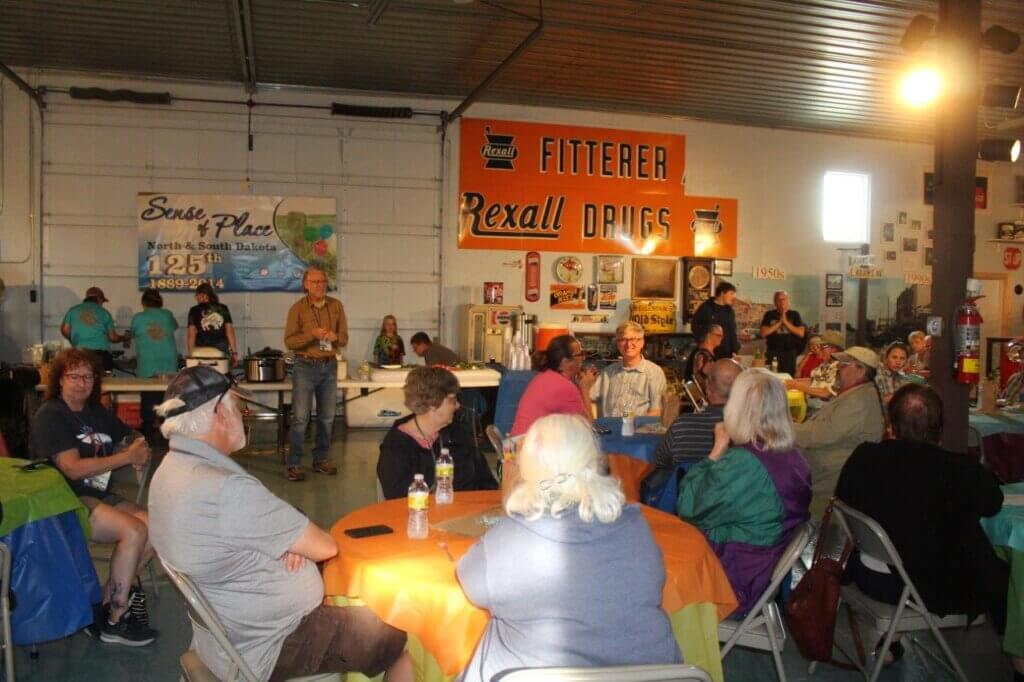
The Symposium ended with a delicious bison Stroganoff dinner in the Dakota Buttes Museum in Hettinger and a bus ride back to Bismarck.
“When will you do this again?” the visitors wanted to know. “What’s next?”
Ours was a compelling story. And I didn’t want people to forget our Buffalo History.
But Wow! We were pretty exhausted—what did we need to do now?
Brainstorming around the Kitchen Table
By this time the Brainstormers were meeting every two weeks or so around my kitchen table.
We had lots of good ideas—so many they seemed overwhelming. Build a Buffalo Center. Bring live buffalo into a nearby pasture. Sponsor tours. Pull together public events. Encourage more Bison research. involve children and young adults. Add teaching curricula that incudes Native American voices telling their stories.
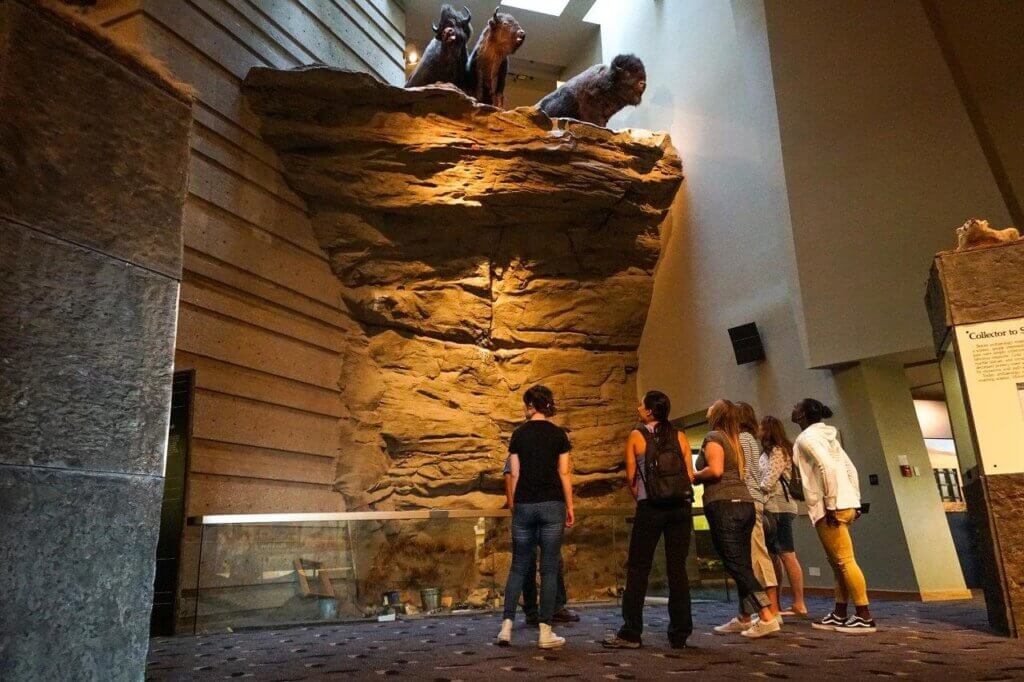
Dramatic exhibits in bison centers inspired us, such as this Buffalo Jump in the many-storied Canadian buffalo center built into a hill at Head-Smashed-in Buffalo Jump.
We’d need a lot of help—volunteers to do all that work. Where will we start? Who will help?
Yes, we have great volunteers. But can we expect them to support one more time-consuming project?
Ours is a small town. One of our concerns, seems like Hettinger gets a bit smaller every year!
Everything that’s innovative here runs on volunteer help. Fire trucks, ambulances, Hospice, Health aids, Clothes Closet, Church officials and all kinds of support groups.
And what if we build a Center, spend all that money—and nobody comes?
But what if we don’t? Will we eventually lose our history again?
Build a Better Website
We have buffalo stories worth telling. But we’re already stretched too thin. What we’d love is tourists coming here—appreciating the wonderful places and stories we have.
But how can we make it happen? As our Brainstorming group discussed it, our mayor Jim–a very perceptive young man—said:
“Wait! We need to have a good Website. That’s how people get their information today.”
He quickly convinced us. A website is the first thing we need, he told us. But it has to be good!
So Val—a former County Extension Leader and Consumer Science teacher—and I sat down together for an afternoon, again at my kitchen table—and listed all the things we wanted on our website.
We zeroed in on the best website we could find for ideas and found some amazing government sites. Sophisticated. Lots of great photos—surprisingly with only small amounts of text! Clean and enticing.


Francie M Berg
Author of the Buffalo Tales &Trails blog


